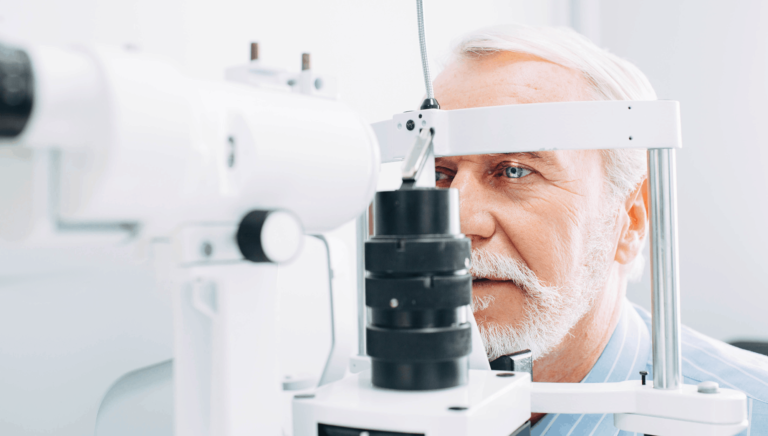
Annemarie Mannion is an experienced journalist who has covered health and wellness for major newspapers, magazines and associations.
The old wives’ tale that eating carrots is good for your eyesight isn’t entirely a myth.
Eating carrots and other colorful vegetables as part of a healthy diet won’t improve your visual acuity, but along with other preventive measures like wearing sunglasses, avoiding smoking, and maintaining a healthy weight, a healthy diet helps prevent some of the illnesses that lead to eyesight problems.
The older a person is, the more likely they are to suffer an eye illness that inhibits their vision. The chances of getting a disease like cataracts, age-related macular degeneration (AMD), or glaucoma increases with age.
Here are some common eye diseases that affect vision in older people and tips for preventing them.
1. Cataracts
When light rays enter our eyes, the cornea and the eye’s natural lens refract the light, focusing it on the retina, enabling us to see. The lens should be clear, but when cataracts form, the lens becomes cloudy.
People over 60 usually start to have some clouding of their lenses. More than half of Americans age 80 and older have cataracts or have had surgery to get rid of cataracts, according to the National Eye Institute.
Ultraviolet light can increase the risk of cataracts and other eye conditions. One way to prevent cataracts is to make a habit of wearing sunglasses that block out ultraviolet rays.
“The number one thing people should do is wear sunglasses when they go outdoors,” says Jennifer Lim, director of retina service at the University of Illinois at Chicago. “Even on a winter day, if it is bright out, wear sunglasses.”
To reduce exposure to ultraviolet light, people can also avoid indoor tanning, wear hats when they’re outside to limit sun exposure, and wear eyeglasses that have a coating that blocks ultraviolet light.
“Don’t go to tanning beds without eye protection,” Lim says. “In fact, you shouldn’t go to them anyway because you can also get skin cancer.”
2. Age-related macular degeneration
People with age-related macular degeneration experience a loss of central vision when a part of the retina, called the macula, is damaged or gets thinner as people get older. People with AMD retain their peripheral vision, but they have trouble seeing the center along with fine details.
People who eat a diet high in saturated fat, are overweight, have high blood pressure, or have a family history of AMD have a higher risk of developing the condition, the National Eye Institute reports. It also is more common in people over 50 years old or those who smoke cigarettes.
“Smoking is associated with increased risk, and that includes secondhand smoke,” Lim says. “If you’re living with someone who smokes or [you’re] around people who smoke, it increases your risk. The bottom line is: Don’t smoke and don’t be around people who smoke.”
A healthy diet with omega-3 fatty acids may help protect your eyes, according to some studies. Lim recommends eating a healthy diet that includes at least one to two servings of fish a week and lots of fruit and vegetables.
3. Glaucoma
When fluid builds up on the front part of the eye, it can damage the eye’s optic nerve. This condition is called glaucoma, which becomes prevalent as people age. Worldwide, nearly 8 million people have lost their sight to glaucoma, and the Glaucoma Research Foundation predicts that the number will increase in the next decade as the general population ages.
You may be at a higher risk of getting glaucoma if you are over 40; are far-sighted or near-sighted; have had an eye injury; or have diabetes, migraines, or high blood pressure, according to the American Academy of Ophthalmology. People of African, Latino, or Asian heritage have a higher risk than Caucasians. In 2010, glaucoma affected about 2% of people in the United States.
Lim recommends visiting an ophthalmologist at least once a year to check for increased pressure in your eyes, which is a sign of glaucoma. Ophthalmologists are trained to detect and treat eye illnesses, she notes.
A trauma to the eye can also cause glaucoma, which is why older people who are unsteady on their feet may want to wear safety glasses to protect their eyes even when they are simply moving about their home.
“Trauma to the eye is a big issue for older people,” Lim says. “People can fall down and hit their eye on the edge of a table or a doorknob and cause an open globe injury. It might look strange to wear safety glasses, but it’s a good thing to protect the eyes.”
The National Eye Institute recommends that people age 60 or older get a dilated eye exam at least once every two years. An eye doctor will use eye drops to dilate the pupil and will look for cataracts, glaucoma, age-related macular degeneration, and other eye issues.








